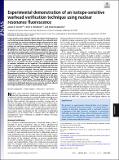| dc.contributor.author | Vavrek, Jayson Robert | |
| dc.contributor.author | Henderson, Brian Scott | |
| dc.contributor.author | Danagoulian, Areg | |
| dc.date.accessioned | 2018-12-17T15:53:44Z | |
| dc.date.available | 2018-12-17T15:53:44Z | |
| dc.date.issued | 2018-04 | |
| dc.date.submitted | 2017-12 | |
| dc.identifier.issn | 0027-8424 | |
| dc.identifier.issn | 1091-6490 | |
| dc.identifier.uri | http://hdl.handle.net/1721.1/119658 | |
| dc.description.abstract | Future nuclear arms reduction efforts will require technologies to verify that warheads slated for dismantlement are authentic without revealing any sensitive weapons design information to international inspectors. Despite several decades of research, no technology has met these requirements simultaneously. Recent work by Kemp et al. [Kemp RS, Danagoulian A, Macdonald RR, Vavrek JR (2016) Proc Natl Acad Sci USA 113:8618–8623] has produced a novel physical cryptographic verification protocol that approaches this treaty verification problem by exploiting the isotope-specific nature of nuclear resonance fluorescence (NRF) measurements to verify the authenticity of a warhead. To protect sensitive information, the NRF signal from the warhead is convolved with that of an encryption foil that contains key warhead isotopes in amounts unknown to the inspector. The convolved spectrum from a candidate warhead is statistically compared against that from an authenticated template warhead to determine whether the candidate itself is authentic. Here we report on recent proof-of-concept warhead verification experiments conducted at the Massachusetts Institute of Technology. Using high-purity germanium (HPGe) detectors, we measured NRF spectra from the interrogation of proxy “genuine” and “hoax” objects by a 2.52 MeV endpoint bremsstrahlung beam. The observed differences in NRF intensities near 2.2 MeV indicate that the physical cryptographic protocol can distinguish between proxy genuine and hoax objects with high confidence in realistic measurement times. | en_US |
| dc.description.sponsorship | United States. National Nuclear Security Administration (award DE-NA0002534) | en_US |
| dc.description.sponsorship | Stanton Foundation. Nuclear Security Fellowship Program | en_US |
| dc.publisher | Proceedings of the National Academy of Sciences | en_US |
| dc.relation.isversionof | http://dx.doi.org/10.1073/PNAS.1721278115 | en_US |
| dc.rights | Article is made available in accordance with the publisher's policy and may be subject to US copyright law. Please refer to the publisher's site for terms of use. | en_US |
| dc.source | PNAS | en_US |
| dc.title | Experimental demonstration of an isotope-sensitive warhead verification technique using nuclear resonance fluorescence | en_US |
| dc.type | Article | en_US |
| dc.identifier.citation | Vavrek, Jayson R., Brian S. Henderson, and Areg Danagoulian. “Experimental Demonstration of an Isotope-Sensitive Warhead Verification Technique Using Nuclear Resonance Fluorescence.” Proceedings of the National Academy of Sciences 115, no. 17 (April 10, 2018): 4363–4368. | en_US |
| dc.contributor.department | Massachusetts Institute of Technology. Department of Nuclear Science and Engineering | en_US |
| dc.contributor.department | Massachusetts Institute of Technology. Department of Physics | en_US |
| dc.contributor.mitauthor | Vavrek, Jayson Robert | |
| dc.contributor.mitauthor | Henderson, Brian Scott | |
| dc.contributor.mitauthor | Danagoulian, Areg | |
| dc.relation.journal | Proceedings of the National Academy of Sciences | en_US |
| dc.eprint.version | Final published version | en_US |
| dc.type.uri | http://purl.org/eprint/type/JournalArticle | en_US |
| eprint.status | http://purl.org/eprint/status/PeerReviewed | en_US |
| dc.date.updated | 2018-12-04T15:47:25Z | |
| dspace.orderedauthors | Vavrek, Jayson R.; Henderson, Brian S.; Danagoulian, Areg | en_US |
| dspace.embargo.terms | N | en_US |
| dc.identifier.orcid | https://orcid.org/0000-0002-6809-9380 | |
| dc.identifier.orcid | https://orcid.org/0000-0001-9133-5559 | |
| dc.identifier.orcid | https://orcid.org/0000-0001-5178-1108 | |
| mit.license | PUBLISHER_POLICY | en_US |
